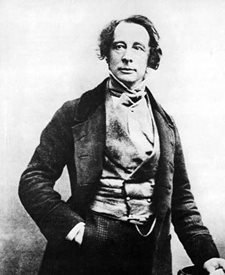Dickens, Charles
I am glad that I never met Charles Dickens. Dickens lived his stories; I would never have been able to know what was really behind his acting. As a man, he desired to be the centre of attention, to always be on stage and to be loved. ‘The street was his stage. He walked the street incessantly.’ (Peter Ackroyd, The Mystery of Charles Dickens, 2002) He was loud, theatrically dressed in vivid clothes fit for the stage, and constantly mimicking the people he saw and met in London. He was an actor, a director and a playwright, but we know him best for his novels.
Dickens’ novels reflect his struggles as a child and his constant effort to put things right in the world. Although beginning his life in rural Kent, his family soon moved to London. His father was put into debtors’ prison. His childhood turned into a grinding job working in a rat filled, rotting blacking factory as he provided a little income for his family. At 10 years old, he could empathise with workhouse children as he worked 10 hours a day labelling shoe blacking bottles. He also visited his father in Marshalsea prison (inspiring the setting of Little Dorrit). You can see images of the prison here: http://www.djarrowsmith.dsl.pipex.com/html/photographs.html Here many people died of disease, heat exhaustion or starvation as much of the food given in charity was reported to have been taken by the keepers. Dickens stated: ‘Ignorance has a very dreadful power to fill prisons.’
Dickens has been described as ‘odd’ as a child and ‘odd’ in his relationships with women. He was a performer in life, on stage and in his work. Mary, his wife’s sister, died at 17 years old. Dickens famously kept her clothes and a lock of her hair. He wore her ring until death. This experience permeates his novels. For example, the characters Nell and Nancy died cruelly despite their heroism.
Dickens’s characters were often caricatures enabling the reader to laugh at the wealthy and sympathise with the vulnerable and poor. His novels are peppered with bullies and defenceless children. Some characters are lovingly more complicated, such as Miss Havisham. She lives in potential opulence but decides to wallow in dust and self pity finding revenge in breaking Pip’s heart. She sits in her decaying wedding dress waiting for Pip to fall in love with Estella. However, most readers will sympathise with her loneliness after the betrayal of her fiancée and her death.
Dickens became a celebrity during his life time. His travels to America proved his fame (see: http://www.bbc.co.uk/news/magazine-17017791) However, he was disappointed with the vulgarity of Americans and their love of money rather than ideals. His book Martin Chuzzlewit, was burnt publically in New York because of his negative descriptions of Americans. Dickens challenged the fact that copyright laws were not applied and authors could not earn their deserved royalties in the US. However, on his second visit, he seemed to like Americans more and was liked in return.
Dickens publicised the luxurious Victorian Christmas that is often celebrated today. His descriptions of the goose, turkey and Christmas pudding in A Christmas Carol and its theme of ‘Good will to all men’ created the enthusiasm and warmth of a family celebration. Dickens exclaimed: ‘A Christmas party! We know nothing in nature that is more delightful! There seems magic in the very name of Christmas. Kindly hearts are united, and all is kindness and benevolence.’
Dickens’s travels to and from his homes in France, Italy, London and the south coast of England finally wore him down. His health deteriorated but he refused to give up the public performances of his work. He said it was: ‘much better to die doing’.
There are so many adaptations of Dickens’ works that there is no room to describe them here. Adaptations of note, for children, Jim Carrey’s 2009 A Christmas Carol and for adults the 1981 BBC version of Great Expectations. There is a newer BBC version of Great Expectations that is a good introduction with respected actors and awe-inspiring settings (http://www.bbc.co.uk/programmes/b018wmhr). However, the older version seems truer to Dickens.
No writer has really been able to emulate the strength and style of Dickens. However, other authors have tried to hold up a mirror to our society. Jane Austen (born before Dickens) successfully looked at the class differences of the middle and upper classes. Dickens went further and portrayed all walks of life from poverty to extreme wealth. Themes of poverty, oppression and ill treatment are still relevant today. Dickens went far to make sure that class differences were emphasised and challenged.



















